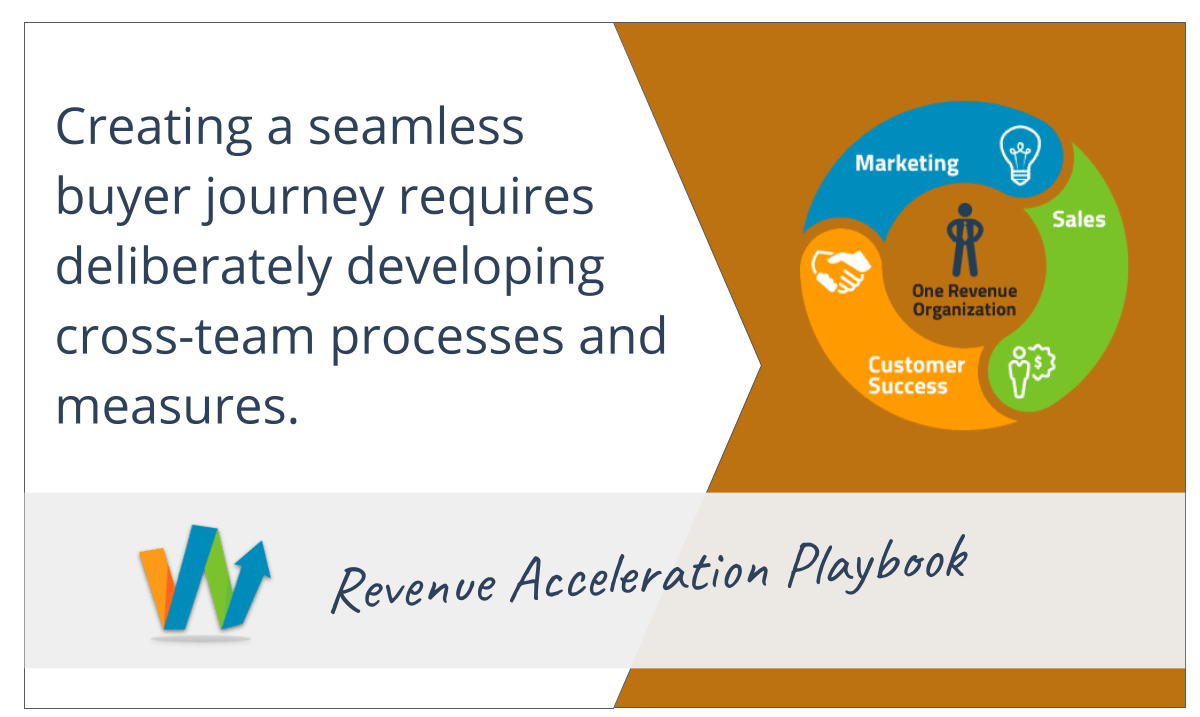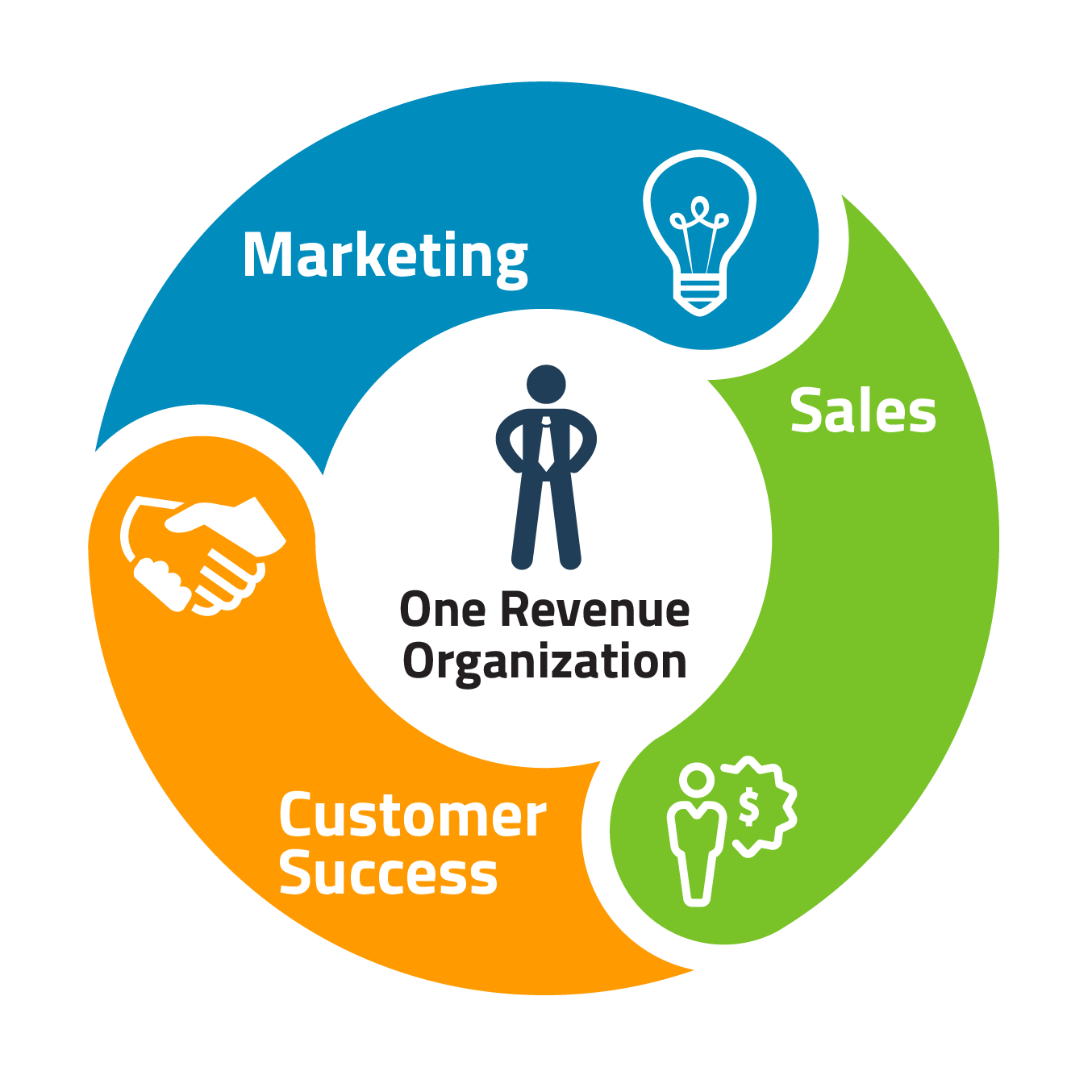 How do you get your marketing, sales, and customer success teams to prioritize the buyer journey over their own department-level goals?
How do you get your marketing, sales, and customer success teams to prioritize the buyer journey over their own department-level goals?
Sales, Marketing, and Customer Success each have their own personality and culture. Sales is stereotypically focused on earning incentive compensation and closing deals to “put points on the board.” Marketing is filled with “brainiacs” who can turn a clever phrase and crunch numbers. Customer Success has “nurturing” types who want to feed and care for customers.
Most companies stop there. They say Marketing is good at identifying and engaging buyers, Sales is good at working deals, and Customer Success is good at customer care and account deepening. So, that’s what we will measure.
Unfortunately, focusing only on team-level goals leads to slower revenue growth. It makes your buyers do too much work, creates friction for buyers and leads to lost deals and missed opportunities to upsell. Creating a seamless buyer journey requires deliberately developing cross-team processes and measures, but the effort is worth it.
Three Revenue Teams, One Revenue Organization

Here are three organizational obstacles you can overcome to build a more seamless, authentic buyer journey that also drives faster revenue growth.
Obstacle #1: Marketing is Singularly Focused on Prospect Engagement
Marketing teams are often measured on engagement metrics. Campaigns are measured on opens, clicks, downloads and other indications of engagement.
But, engagement tells us little about how well we are connecting to meaningful buyer goals and the extent to which our prospecting activities are perceived as value added toward clear objectives. For Marketing, the only real way to know how strongly marketing and prospecting campaigns are landing with potential buyers is by connecting forward to actionable sales opportunities.
To overcome this obstacle, in addition to prospect engagement, measure prospecting velocity, which connects Marketing and Sales. Prospecting velocity measures how many new opportunities come from each 100 or 1,000 engaged contacts in a campaign.
If your team commits to measuring prospecting velocity, then each prospecting campaign becomes an opportunity to test a key buyer goal area from your company’s value narrative playbooks. If you commit to head-to-head comparison of prospecting campaigns, it becomes possible to generate evidence on which categories of qualified leads convert at the highest rate to an initial discovery call and, of these, which convert from an initial discovery call to a sales-qualified opportunity. Running these marketing tests helps a company make sure it is staying strongly focused on an authentic buyer journey and inviting the right prospects into value-added discovery calls.
Marketing Metrics and Prospecting Velocity Metrics

Obstacle #2: Sales is Singularly Focused on Deal Velocity
Sales teams are traditionally measured on deal velocity, which means the rate at which new sales opportunities move to closed won deals, the average time it takes to move to closed won, and the value of the closed won opportunities.
However, measuring success on only the basis of closed deals does not encourage your sales teams to think about developing customer value in ways that maximize overall account value.
To address this obstacle, in addition to deal velocity, begin measuring account velocity, which connects Sales and Customer Success. For your sales team, connecting forward to customer success means thinking beyond the first close. It means that they are also thinking about the timeframe to the first upsells and the overall increase in account value in the first twelve months after the initial close.
Measuring account velocity changes the relationship between your Sales and Customer Success teams. No longer is the focus in Sales to do an initial discovery to get an initial deal closed that will be handed off to Customer Success for care and renewal. Instead, your sales team’s focus shifts to doing as deep a discovery as possible during the sales process to identify multiple potential goal areas so they can effectively hand off information on all buyer goal areas to Customer Success. If your Sales team does this well, it enables your Customer Success team to work quickly toward second, third, and fourth upsell opportunities that expand customer value while expanding account value.
Sales Metrics and Account Velocity Metrics

Obstacle #3: Customer Success is Singularly Focused on Care and Renewal
Customer success teams play a critical role in maintaining a company’s growth trajectory through their work on renewal and incremental upsells. While this work on renewal and incremental upsells is critical, it is actually not the Customer Success team’s most significant contribution to overall growth. Even more important to dynamic growth is their role in building segment velocity, which connects Customer Success to Marketing.
Customer Success Metrics and Segment Velocity Metrics

Segment velocity is the pace at which customers in different segments reference, refer, and evangelize a company to their segment peers. Very few companies recognize or incent the critical role the customer success team plays in building reference value, developing segment-specific success stories, and nurturing relationships with customers who can evangelize to other customers. However, activating Customer Success in these areas supercharges customer care, turns team members into customer evangelizers, and accelerates organizational learning that drives revenue.
Segment velocity is hard to measure directly, but if you decide to move in this direction there are a few key proxy measures. The first and simplest approach is to look at the total number of your key market segments that are covered by client success stories. A second measure you can use is the number of market segments in which you have a critical mass of three to five success stories. This starts to build a picture of consistent success and deeper understanding of the customer voice in that target market segment. A third proxy measure is the total number of new sales opportunities that come from existing customer references.
Key Takeaway: Shift to a “One Organization” Mindset
Most go-to-market teams want to create a value-added buyer journey that removes friction and builds engagement. However, a mindset of hyper-focus on team-level metrics often gets in the way. A key opportunity to accelerate a seamless buyer journey is building cross-team processes and alternative metrics that keep your buyer at the center of internal hand-offs between your go-to-market teams. Once you make this shift, your go-to-market teams operate less as siloed departments and more as one revenue organization tuned to deliver revenue growth.
.
